|
Bob's Long Long Long bio page V
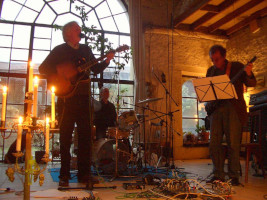 In April 2007, Peter Blegvad, Chris Cutler and John Greaves, who I'd worked with previously on Just Woke Up and Hangman's Hill came to La Borde Basse to rehearse for their appearance at the first Rock in Opposition festival at Cap Decouverte, which was to take place two days later. On the evening of their last day of rehearsal, I happened to pass through the room as they finished playing Bee Dream and heard them saying they missed the droning guitar feedback which is a feature of the song on the album. My ears pricked up, "I could do that" I said, went and got my most feedback-prone guitar, we ran through the song and at the appropriate moment I let it howl away. (I am very good at controlled guitar feedback, if I may humbly say.)
In April 2007, Peter Blegvad, Chris Cutler and John Greaves, who I'd worked with previously on Just Woke Up and Hangman's Hill came to La Borde Basse to rehearse for their appearance at the first Rock in Opposition festival at Cap Decouverte, which was to take place two days later. On the evening of their last day of rehearsal, I happened to pass through the room as they finished playing Bee Dream and heard them saying they missed the droning guitar feedback which is a feature of the song on the album. My ears pricked up, "I could do that" I said, went and got my most feedback-prone guitar, we ran through the song and at the appropriate moment I let it howl away. (I am very good at controlled guitar feedback, if I may humbly say.)
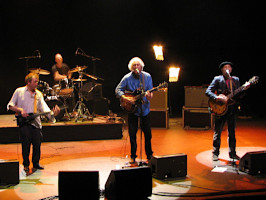
They loved it, and before I could put the guitar down Peter said "since you're here and got the guitar, what if you played a little on this other song too?" Then someone else said "Oh yeah and maybe on this one too" and before I knew it, I was playing on half the set, with only that one evening's rehearsal. Peter's songs are full of unlikely chords and changes, so with very little time to work anything out I kept my parts extremely minimal on that gig! At this show I played the Epiphone guitar Mike Johnson had given me some years previously as payment for mixing a Plague album. It had a bit of a woollier sound than I prefer but wasn't a bad instrument. After the show Peter handed me a wad of cash...I hadn't even thought about being paid so that was a nice surprise! It was a goodly sum, so I went right to the music shop in Albi and bought the guitar I'd been dreaming about for months, I'd seen one there when I bought a set of strings the day before: the pale blue Gretsch G5127. Glad I did too - this model was discontinued barely two years later! |
|
Being our first show, and with very little time to rehearse as a group, it wasn't the greatest performance ever, but we loved playing together and wanted to do more, so a year later in 2008, along with keyboardist / sax player / chemistry experimenter / all-around clever and helpful fellow Jason DuMars we did a short tour, perhaps 6 or 7 cities around the midwest and southeast USA, as Bob Drake's Cabinet of Curiosities (once again thanks to Chris Cutler for suggesting the name.) I recall many of these gigs as playing to the one or two members of the other band who hadn’t gone out to eat, although there were some fine shows with very interested and enthusiastic audiences as well. The show in Watseka Illinois was exceptional in that regard, there are some videos here and here. The Cabinet of Curiosities did the one tour and that was that. 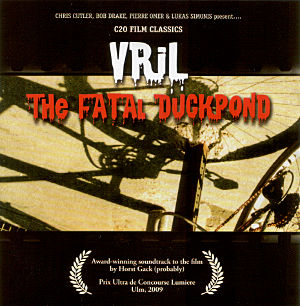 In 2009, Vril made a second album The Fatal Duckpond, again with guitarist Lukas Simonis, me on bass, Cutler drumming, and now with second guitarist Pierre Omer. As with our first album, Frank Key came up with the song titles and did the album art.
In 2009, Vril made a second album The Fatal Duckpond, again with guitarist Lukas Simonis, me on bass, Cutler drumming, and now with second guitarist Pierre Omer. As with our first album, Frank Key came up with the song titles and did the album art.
Other things I did in 2008 - 2009 include recording and mixing of: |
|
By then I was ready to get started on my next album Bob's Drive-In. It had been nearly five years since I'd finished The Shunned Country, the long break I’d needed from songwriting. I had a clear idea for a new album and by late 2010 all the music and lyrics were written and ready to record. But before recording I wanted to change some things in my drumming.
Anyhow, back to my drumming. All my 40-some years of playing I’d used medium-to-light sticks and never understood why a drummer would use thick, heavy “clubs” like these Pete had sent me. I tried them out just for the hell of it. They felt strange at first, I played for 10 minutes or so and then went back to my usual sticks. What a difference! With the heavy sticks a lot more sound, very focussed and punchy, came from the drums with a lot less effort. I could just use my wrists and stay very relaxed, it looked like I was barely doing anything yet a big punchy sound came out. I’ve used those heavy sticks ever since (thanks Pete!) The drum sound was also much improved by the new Tama snare drum I’d bought while recording The Shunned Country, so Cutler's old broken Henry Cow snare was finally allowed to retire. It would still be a year before I built the strawbale/earth studio where I’ve done all my albums beginning with Lawn Ornaments, so to concentrate on my drumming for a while I moved the kit to the attic, a space with a low, fabric-covered ceiling and a rather soft wood floor, no reverberation, very “dry” sound, not the sort of place I would normally choose to record in. But after some weeks practicing the drums up there, gradually getting them tuned to the room, they sounded great there, so I ended up recording not just the drums but the whole album up there in the attic! The dry, close-up sound suited the music and helped give the album its character. Another big change I made at this time was using flatwound strings on my old Rickenbacker 4001 bass for the first time. I'd used roundwounds since I bought it in 1974, but I loved the sound with the flatwounds (D’Addario “Chromes”) and have stayed mainly with those ever since, though I'll put on the roundwounds when desired for a song or project which wants more of "that" kind of sound.Once I finished recording the Bob's Drive-In songs, I wanted to get a band back together for a modest livingroom tour, like the one we'd done in 2008. Dave Kerman and Dave Campbell were up for it, but this time I wanted a second guitarist, though I had no idea who it might be. This pestered me for a while, and at the 2010 RIO festival in France, Maggie Thomas suggested I ask Kavus Torabi, who was there to play with one of his many groups. I said "come on, he's so busy and never heard of me anyway!" but at Maggie’s prodding I got up the nerve to ask, and lo, he was thrilled with the idea, and did know of my work.
Rather than forget the whole idea with such a great band ready to go, I suggested instead that we learn a set of my new songs, with new arrangements by the whole group and record them live here at La Borde Basse with an audience. The others loved the idea, we did the show in May 2011 and that became "Part II" of Bob's Drive-in, released in October 2011 with cover art by one of my long-time favourite cartoonists Mike Kazaleh. Back at home, I finished my new strawbale/wood/earth studio out in the garage, and moved all my instruments and gear in, and that's where I've done all of my solo albums and rehearsing since. By 2012 I had a clear idea for a new album. Because Bob's Drive-In had a deliberately stripped-down production and dry, close-up sound, I wanted to go to the opposite extreme. So the working title for what became Lawn Ornaments was The Overproduced Album and it succeeded in achieving that! I didn't just double guitars or vocal parts, I overdubbed them 4 times or more (there is one section with 100 overdubbed guitars), often two drumkits and two bass parts, many organs, instruments recorded with the microphone 50 meters away outdoors, pianos through a wah-wah pedal and amplifiers, my first ever trumpet playing, anything I could find and lots of it. About the time I started working on Lawn Ornaments, Chris Cutler was commissioned by The Museum of Modern Art in Barcelona to come up with a podcast series on a musical topic. That's how the still ongoing Probes series came into being. For these, Chris does all the research and gathers the materials for each program, then here at La Borde Basse reads his texts, I record and edit them, edit the appropriate musical excerpts to illustrate his points and topics, and we have a fun time putting it all together. It's been quite a musical education for me! And always interesting from the engineering angle: how to get the scores of little examples and excerpts to sit together in one program. He'll ask me to do seemingly impossible edits: splice two utterly dissimilar sections of a piece of music seamlessly together, or if I can somehow change one letter in one of his spoken words to make into a different word so he doesn't have to have to re-record it! Working on this series very importantly led me to the music of Machaut and the Ars Nova, which have greatly influenced my songwriting since. Another new inspiration came at the same time, the music of Tim Smith. I had heard about Cardiacs over the years, had been told by others that some of my music shared similar qualities, but I hadn't heard them. My friend Kavus Torabi had been a Cardiacs member, and gave a me some CDRs to introduce me to this world of music, one of which was The Sea Nymphs. One day in 2012 as I was about to get to work tiling the garage, I dug out those CDRs Kavus had given me some months earlier, randomly picked The Sea Nymphs, stuck it in the player, picked up my trowel and turned to get to work. About 40 seconds in, when the organ and vocals enter, I was transfixed, literally "stopped in my tracks", stood there and listened to the whole album, then I played the whole thing again. I don't think I'd played an album straight through twice in a row since the first time I heard Hopes and Fears by the Art Bears in 1978. Then I figured I'd better have a listen to some Cardiacs, looked them up and the first song I heard was this one. Discovering both Machaut and Tim Smith's music showed me once again and in a big way, there is still much that can be done with chords and melody using our Western scale of just twelve little notes!
|
|
Getting to know some of the Cardiacs-related people has also led to many wonderful friendships and gigs, I played at the 2017 Alphabet Business Convention, the Spring Symposium, and many wonderful backyard get-togethers. A look at the names on the posters for those events will give you a starting place to discover some of the great music going on out there.. And now that I mentioned them Cardiacs people, in 2014 I mixed Knifeworld's album The Unravelling , and in 2016 the group came here to La Borde Basse and I recorded and mixed Bottled Out of Eden. Here is a short video shot during the recording sessions. I remember when it was time to record the horns, Ollie the sax player asked me - while the others stood nearby with a palpable air of trepidation I thought - if I was intending to record them all individually. HELL no I said, do it all together in this very room! Everyone was relieved - I think they must have done it individually on the previous recording. I don't like doing that for lots of reasons. For one, it obviously takes much, much longer, and the player or other band members may become overly focused on things like tiny tuning discrepencies or infinitesimal sound details that don't matter. As part of a section, those little tuning and timing variances, along with rattling metal, key clicks, squeaks and so on, are some of the very things that make the section sound like something alive, and playing together lets everyone have a lot more fun in the process too. I like to keep a session rolling along, and if it comes down to it, prefer "inaccurate" but lively, enthusiastic performances over more careful, note-perfect recitals.
|
|
 Arx Pilosa, that’s what happened next. I had a definite starting idea – very poppy tunes with the emphasis distinctly on vocals and melody – the latter a concept I felt I was finally
beginning to get a tenuous grasp on, boosted along by my recent discoveries of Machaut and Tim Smith. Sonically it would be clearer and more close-up sounding than the previous album. (OK, almost anything would have been!)
Arx Pilosa, that’s what happened next. I had a definite starting idea – very poppy tunes with the emphasis distinctly on vocals and melody – the latter a concept I felt I was finally
beginning to get a tenuous grasp on, boosted along by my recent discoveries of Machaut and Tim Smith. Sonically it would be clearer and more close-up sounding than the previous album. (OK, almost anything would have been!)My recording process was always extremely basic, and by the time I did Arx Pilosa, the whole process had become so simple, streamlined and organic I could do things like record a lawn mower and ridiculously huge tom-toms in the song Letter of Complaint and it seemed like what ought to have happened. Production was actually quite detailed and always changing, but it was all for the song. I'm sure this is largely because the musical and lyrical substance of the songs was improving, or so I like to think! It was also my first album where the lyrics were often directly about anthropomorphic animals, the opening track Dret Tancat Saves the Multiverse is one good example. The album was released by ReR in 2016.
 Also released around the same time is this album by Bing Selfish and The Multiverts, who happen to have a rather fine anthropomorphic bear as a drummer, as this video will attest to.
Also released around the same time is this album by Bing Selfish and The Multiverts, who happen to have a rather fine anthropomorphic bear as a drummer, as this video will attest to.
|
|
At this juncture it's probably a good time to mention a word which by now had become a frequent adjective used by others to describe my music: psychedelic. I do love the word in its literal sense: psyche: the soul, and delos: to become visible. “The spirit becoming visible”! That’s what I think music and art does, whether the maker thereof is aware of it or not. As for the ingestion of substances labelled as such, the closest I probably came is the time in 2010 when I tried cannabis for the first and last time. Besides some not especially enjoyable visual and time disturbances, it made me feel like I had the worst case of jetlag imaginable. Note that I ate it, because I didn't want to smoke, and many people have told me it's better smoked or vaporised but I'll give it a miss. For the light, relaxing buzz effect I'll stick with my two (or three) beers!
Speaking of time disturbances, let's step back a little to 2015, probably about halfway through recording Arx Pilosa: I
was paid for something, I don’t remember what, which allowed me to afford a trip to the USA to visit
my family. I decided it would be the time to do my first real solo show, just me and an electric guitar. I was going to Denver anyway so I chose to do this there at the Mercury Café, a place I felt comfortable in, having played there in many bands all through the 80's, and its manager Marylin had always been extremely supportive and encouraging to all Denver artists and musicans throughout those desperately hungry years of the 80’s. "Stage fright" was something I had never experienced or even understood until the moment I stepped onto the stage for that show. I was so nervous I played the 60-minute set in about 40 minutes, and was practically blacked out the whole time, running on some kind of auto-pilot. I really wasn't there! From time to time I'd come back to myself just long enough to wonder why I was doing it, heard myself playing the wrong chord and a thin wobbly voice trying to sing, then mercifully go blank again. I didn't feel much better when it seemed people had enjoyed it! I swore NEVER again: why put myself in a position where I felt so nervous, exposed, unprepared? But speaking with other singer-songwriter friends I respect who had been doing solo shows for years, Bing Selfish notably, most of them said they felt that way to some degree the first few times. And something kept telling me I ought to do it at least until I could get over the unnecessary fear, and actually be “present” during the show.
|
|
|
|
 In June 2016, Peter Blegvad (guitar, vocals, songs), John Greaves (bass), Chris Cutler (drums) and Karen Mantler (organ and background vocals) turned up here at la Borde Basse, and with me also on guitar, background vocals and engineering, we made the Go Figure album. It was released by ReR in December 2017.
In June 2016, Peter Blegvad (guitar, vocals, songs), John Greaves (bass), Chris Cutler (drums) and Karen Mantler (organ and background vocals) turned up here at la Borde Basse, and with me also on guitar, background vocals and engineering, we made the Go Figure album. It was released by ReR in December 2017.
|
|
 In October 2016, inspired by reading old books about Italian gardens, places such as Isola Bella, and especially Villa Pliniana with its unusual architectural features and mysterious, intermittent spring, I wrote and recorded an atmospheric song about an imaginary mysterious Italian garden island perhaps inhabited by anthropomorphic animals, called Isola dei Lupi. That seemed like a good overall theme for a whole album, and by June 2018 L'Isola dei Lupi was finished and released in October by ReR with another wonderful batch of artwork by Joe Mruk. This album took my usual way of composing to its limit; if I was going to carry on from where I'd arrived with songs like Hollowfang's Tower, Sleepy Critter, or The Ascension of Greyfoot Badger I was going to have to have to find a new way of working. I did - more about that later!
In October 2016, inspired by reading old books about Italian gardens, places such as Isola Bella, and especially Villa Pliniana with its unusual architectural features and mysterious, intermittent spring, I wrote and recorded an atmospheric song about an imaginary mysterious Italian garden island perhaps inhabited by anthropomorphic animals, called Isola dei Lupi. That seemed like a good overall theme for a whole album, and by June 2018 L'Isola dei Lupi was finished and released in October by ReR with another wonderful batch of artwork by Joe Mruk. This album took my usual way of composing to its limit; if I was going to carry on from where I'd arrived with songs like Hollowfang's Tower, Sleepy Critter, or The Ascension of Greyfoot Badger I was going to have to have to find a new way of working. I did - more about that later!
|
|
So what did I do? Assembled a set of my most demanding, difficult to play and sing material, and for weeks before the show rehearsed only this set, several times every day, over and over. I never thought I'd hear myself say this, but I really did over-rehearse for that show. Without even realizing it, I wasn't having fun because I had gradually slipped into trying too hard to be "good", as in, "don't make any mistakes."
A little side note: Anyhow - everyone at the Rock in Opposition show enjoyed it...except me! I knew the set had been videoed, but could never bring myself to watch it because I remembered it as such a disaster. Only this year did I finally dare to watch it, expecting the worst, but it was BLOODY GREAT. Lesson learned!
|
|
Composing songs with what I call my "old" way: a guitar in my hands, recording ideas in order to store, recall and develop them, relying much on memory, had become slow and cumbersome as the music for L'Isola dei Lupi evolved. I had started “discovering” techniques I thought were unique, such as recording a short melody and chord progression and listening to it backwards to hear if was good that way too. Sometimes it is, so I’d learn it and make it part of the song’s chorus or bridge. I thought this was some brilliant composing idea I'd come up with myself...but a few months later when I first started using notation, I learned this is a very old technique, “retrograde”, used for centuries by composers, one of many such handy techniques. What else had I been missing! It was time once and for all to learn about notation. I had tried several times over the decades to learn notation from books and found it impossible. So dry, mathematical and intimidating I’d give up before starting. One or two friends tried to teach me, but soon lost their patience with my inabilty to learn in ways that seemed simple for them. I figured today however, in 2018, there must surely be a number of softwares available with which one could put notes on a stave, with the mouse for example, and immediately hear them played back. That's the kind of instant feedback I learn really quickly from. An internet search led me to the free, open-source Musescore software with which one can do exactly that (and much more). After the usual "how the hell does this work" period, I realized how absolutely brilliant musical notation is, suddenly glimpsed how so much music I love had been composed, it was an absolute revelation!
On The Gardens of Beastley Manor I used it as a simple melodic keyboard instrument to get those plaintive, Theremin-like tones. I was also thinking of the Onafets, a home-made oscillator used in the 60's Outer Limits music. The MS20 can be quite expressive. It's monophonic, meaning you can only play one note at a time, so while playing the keys with one hand I always twiddle the knobs with the other, adding more or less portamento, changing the attack/release times, opening or closing one of the filters, etc. Its slightly unstable oscillators also contribute to its strangely organic quality. |

 On 13th October 2019 I performed at the Alterazioni concert series at the fantastic Villa Litta di Lainate near Milan, Italy. So many of my songs and lyrics are inspired by old Italian gardens and architecture, so it was a dream come true to play in a place like this! Just outside the room where I played is a 15th century nymphaeum, I was so enthralled by its dripping fountains, water games and other features, a little old man who operates them took me behind the scenes to show me how it all worked. Needless to say I was in heaven! There is video from the show here, and I was interviewed by Open Magazine after the show here.
On 13th October 2019 I performed at the Alterazioni concert series at the fantastic Villa Litta di Lainate near Milan, Italy. So many of my songs and lyrics are inspired by old Italian gardens and architecture, so it was a dream come true to play in a place like this! Just outside the room where I played is a 15th century nymphaeum, I was so enthralled by its dripping fountains, water games and other features, a little old man who operates them took me behind the scenes to show me how it all worked. Needless to say I was in heaven! There is video from the show here, and I was interviewed by Open Magazine after the show here.
|
|
Two days before that Villa Litta show, I played in Basel Switzerland, did my solo set and then a few songs together with old pal drummer David Kerman. As we played, I noticed my left hand was feeling a bit weak or slow. A few minutes later the middle finger curled into the palm, and could only be opened by pulling it with the other hand. No pain or discomfort, I figured it was just some strange cramp and tried to carry on, but a few minutes later the same thing happened. It was impossible for me to play, so I excused myself and Dave took requests and did a very entertaining solo drum set. Two days later at the Villa Litta show I played very cautiously, and managed to do the show without having to stop, though my left hand felt strange, curiously slow and weak. and looking at the video from the show it's pretty evident I had barely slept the night before because I'd spent most of it trying to learn about what was wrong with my hand. Returning home a few days later, I found that whenever I played a guitar the middle finger occasionally wouldn't respond. It ONLY happened while playing guitar, not bass or piano, or in any other situation. Finally I learned it's a condition called musician's focal hand dystonia. As I understand it: on the brain's cortex is a "map" of the hands, which send the signals to the appropriate nerves and muscles of each finger. In a musician, or anyone who practices small, repetitive movements of the fingers for many years, this map of the hand can grow larger, until the areas of the fingers start to overlap, then the signals don't go where they were intended, thus the appropriate appendage simply doesn't respond. Reading about the condition, including accounts and videos from many musicans who have had it, I learned it's possible to get around by seemingly simple means such as using different fingerings, or subtly changing the way a familiar instrument feels, apparently order to make the brain create new neural pathways for the activity. There is endless information about the condition online, but if it happens to you, don't panic, it can (probably) be fixed!
Which reminds me - I've also made things easier by starting to use a thumb restraint. I had arthritic pain in the thumb joint while playing, for DECADES, and of course just ignored it until it got to where it was so painful after ten minutes of playing I'd have to stop. At that stage I went to the doctor, who prescribed one of these. It entirely stops the pain, and doesn't get in the way of playing at all. So if you have that pain at the base of the thumb due to simple arthritis, don't wait 20 years before doing anything about it, because it'll only get worse. GET ONE OF THESE -----> |
|
 In September and October 2019 I wrote and recorded a set of pieces called 11 Miniatures for Piano and Bass.
Then I started setting up a UK tour for a new band which would have been a trio – me on guitar/vocals, David Kerman drumming and David Campbell on bass. Gigs were lining up for the Summer of 2020, including a real good festival or two, but by February it was obvious that wasn't gonna happen due to the exciting new pandemic. (One of these days, we do hope this Drake/Kerman:Campbell POWER TRIO will get together!)
In September and October 2019 I wrote and recorded a set of pieces called 11 Miniatures for Piano and Bass.
Then I started setting up a UK tour for a new band which would have been a trio – me on guitar/vocals, David Kerman drumming and David Campbell on bass. Gigs were lining up for the Summer of 2020, including a real good festival or two, but by February it was obvious that wasn't gonna happen due to the exciting new pandemic. (One of these days, we do hope this Drake/Kerman:Campbell POWER TRIO will get together!)
Go to page 6 |
 It was my first time playing onstage with John and Peter, there was a good feeling and all agreed we had to do it again sometime.
It was my first time playing onstage with John and Peter, there was a good feeling and all agreed we had to do it again sometime. 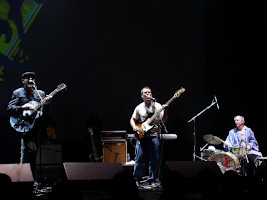 I had never considered trying to play my own music live until 2007 when I was invited to play at
the North East Art Rock festival (or NEARfest) in Bethlehem Pennsylvania. I accepted and asked
David Kerman, who was going to be at the festival anyway with another group, to play drums, and through an
I had never considered trying to play my own music live until 2007 when I was invited to play at
the North East Art Rock festival (or NEARfest) in Bethlehem Pennsylvania. I accepted and asked
David Kerman, who was going to be at the festival anyway with another group, to play drums, and through an  I put a front head on the bassdrum - that gives a rounder, more substantial sound and less of a sharp attack - and also changes the way the pedal reacts when it contacts the drumhead, since the drum is now air-tight. Then I set about learning to play 'heel down" (not lifting the heel from the bassdrum pedal) at the urging of one of the best drummers I'd ever played with, Mark Fuller. After some days of struggling to get comfortable playing heel down on a two-headed bassdrum, I began to hear the benefits of playing that way, the groove was deeper, and it also allows for more dynamic punches. I also began using heavy drumsticks: a pair of Zildjain Rock
sticks, sent to me by Rare Earth's
I put a front head on the bassdrum - that gives a rounder, more substantial sound and less of a sharp attack - and also changes the way the pedal reacts when it contacts the drumhead, since the drum is now air-tight. Then I set about learning to play 'heel down" (not lifting the heel from the bassdrum pedal) at the urging of one of the best drummers I'd ever played with, Mark Fuller. After some days of struggling to get comfortable playing heel down on a two-headed bassdrum, I began to hear the benefits of playing that way, the groove was deeper, and it also allows for more dynamic punches. I also began using heavy drumsticks: a pair of Zildjain Rock
sticks, sent to me by Rare Earth's 
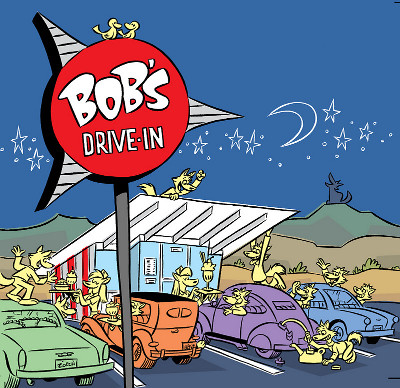 With this excellent band ready to get together, I spent months looking for gigs, without finding
even a single livingroom show, anywhere. (If I had known the people and venues I've encountered
since on my solo tours, I'm sure I could have found something!)
With this excellent band ready to get together, I spent months looking for gigs, without finding
even a single livingroom show, anywhere. (If I had known the people and venues I've encountered
since on my solo tours, I'm sure I could have found something!) 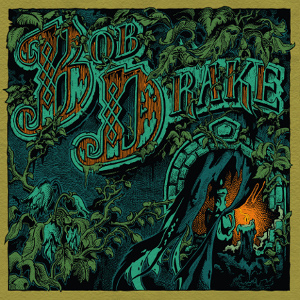 As if the new musical inspirations weren't enough, as the album was nearing completion and I began wondering about the cover and artwork, an email
arrived out of the blue from
As if the new musical inspirations weren't enough, as the album was nearing completion and I began wondering about the cover and artwork, an email
arrived out of the blue from 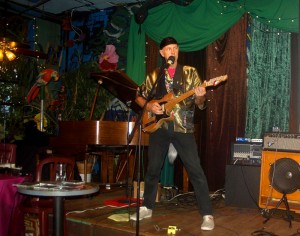
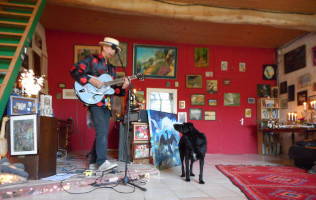
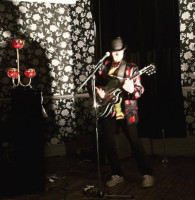 Thus in 2016 I set up a few more gigs: one here at home for some friends, just to "prepare myself", and three
in London. For these shows I was still nervous, and not at all sure yet about who this
character was that was playing these songs onstage, but at each gig I found I was starting to get over
that paralyzing fright, enjoying it a bit more.
Thus in 2016 I set up a few more gigs: one here at home for some friends, just to "prepare myself", and three
in London. For these shows I was still nervous, and not at all sure yet about who this
character was that was playing these songs onstage, but at each gig I found I was starting to get over
that paralyzing fright, enjoying it a bit more.

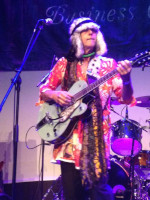 After a few more shows, I began to love it, and it became one of my favourite things to do. Between 2016 and the present (November 2019) I’ve done perhaps 50 - 60 solo shows mostly in the UK, also France, Switzerland and Italy. It has been one of the most rewarding things I have ever done, if not always financially, certainly socially, artistically and personally.
After a few more shows, I began to love it, and it became one of my favourite things to do. Between 2016 and the present (November 2019) I’ve done perhaps 50 - 60 solo shows mostly in the UK, also France, Switzerland and Italy. It has been one of the most rewarding things I have ever done, if not always financially, certainly socially, artistically and personally.
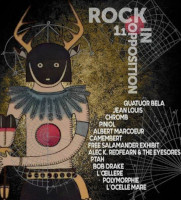 In September 2018 I performed at the
In September 2018 I performed at the 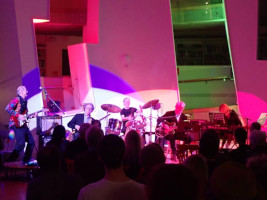 In April 2019, the Peter Blegvad Quintet, same group who recorded Go Figure mentioned above, played shows in Lyon and London. There is video from
In April 2019, the Peter Blegvad Quintet, same group who recorded Go Figure mentioned above, played shows in Lyon and London. There is video from 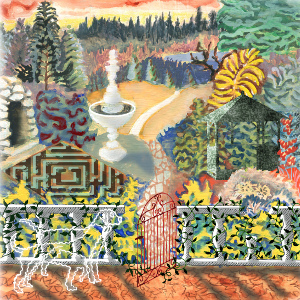 I took to it immediately and within a few months
had an album’s worth of instrumental pieces, all with a particular kind of flavour which couldn’t have happened working my old way, completely composed and scored without ever having picked up an instrument to look for an idea. I then learned them on the
real instruments, and recorded
I took to it immediately and within a few months
had an album’s worth of instrumental pieces, all with a particular kind of flavour which couldn’t have happened working my old way, completely composed and scored without ever having picked up an instrument to look for an idea. I then learned them on the
real instruments, and recorded  One of the main instruments on the album is my old Korg MS20, which I have used for decades mostly for its ability to (sort of) track a guitar or bass plugged into it. Some examples: it's the squiggly sounding melody you hear on 5UUs Well...not Chickenshit just after I sing "don't come to me for squat". (you can hear it
One of the main instruments on the album is my old Korg MS20, which I have used for decades mostly for its ability to (sort of) track a guitar or bass plugged into it. Some examples: it's the squiggly sounding melody you hear on 5UUs Well...not Chickenshit just after I sing "don't come to me for squat". (you can hear it  As it turns out, I had an easy way to get around it - starting to use the middle finger of the left hand again, which I'd rarely used on guitar since the tip was cut off back in 1986. Late in 2019 I began experimenting with making a false tip, à la Black Sabbath’s
As it turns out, I had an easy way to get around it - starting to use the middle finger of the left hand again, which I'd rarely used on guitar since the tip was cut off back in 1986. Late in 2019 I began experimenting with making a false tip, à la Black Sabbath’s 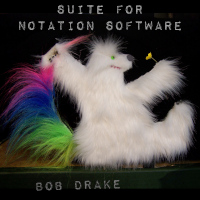 I think the charmingly artificial sounds that come
I think the charmingly artificial sounds that come